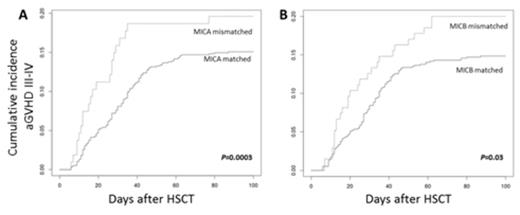Abstract
Background: Graft-versus-host disease (GVHD) is a major cause of mortality after unrelated hematopoietic stem cell transplantations (HSCT). Despite the development of modern immunosuppressive strategies, a nearly perfectly controlled compatibility of the classical HLA genes (HLA-A, -B, -C, -DRB1, -DQB1, and -DPB1) and availability of numerous so-called minor histocompatibility antigens (e.g. HY or HA-1), its incidence remains largely unexplained to date. MIC genes (MHC class I chain-related) - a distinct lineage of MHC class I genes – are promising candidates to explain, at least partially, the incidence of GVHD in HLA-matched transplantations. MICA and MICB are highly polymorphic (100 alleles for MICA and 40 for MICB) and encode functional cell-surface glycoproteins up-regulated by cell stress. They interact with NKG2D, an activating receptor expressed on the surface of cytotoxic αβ CD8+ and γδ T lymphocytes and natural killer cells. MIC genes are already known to have a HLA-independent effect on solid graft outcomes and may play a similar role in HSCT by triggering GVHD.
Objective: The objective of the present study was to determine the impact of donor/patient matching at the MICA and MICB loci on the incidence of GVHD in patients undergoing unrelated HSCT.
Methods: We retrospectively analyzed a multicenter cohort of 1072 unrelated transplantations performed between 1996 and 2013. All donor-recipient pairs were fully typed at high resolution for HLA-A, -B, -C, -DRB1, -DQB1, and -DPB1 and were matched for ten of ten HLA alleles (HLA 10/10 matched). High resolution genotyping of MICA and MICB was performed by sequenced-based typing in order to define matching grades between donors and patients. The endpoints of the study were acute and chronic GVHD. Apart from HLA-DPB1 matching, statistical models were adjusted for major clinical variables which have been shown to be associated with outcome (patient’s age, patient’s and donor’s sex, patient’s and donor’s serological status for cytomegalovirus, year of transplantation, time to transplantation, transplantation center, source of stem cells, conditioning regimen, GVHD prophylaxis, treatment with anti-thymocyte globulin, disease category and severity at transplantation).
Results: Of the 1072 transplantations, 134 (12.5 %) and 380 (35.4 %) were mismatched at the MICA and MICB locus, respectively. Both MICA and MICB mismatches were significantly associated with an increased incidence of severe acute GVHD (grades III-IV) in univariate and multivariate models (multivariate model: HR = 2.32, 95 % CI = 1.84-2.92; p=0.0003 for MICA and HR = 1.49, 95 % CI = 1.24-1.79; p=0.03 for MICB). At day 100 post-HSCT severe acute GVHD incidences in mismatched vs. matched transplantations were 19.62 % vs. 15.08 % and 20.00 % vs. 14.84 % for MICA and MICB, respectively (Figure 1). Chronic GVHD was associated with MICA and MICB mismatches in univariate analysis (HR = 1.55, 95 % CI = 1.27-1.89; p=0.029 for MICA and HR=1.38, 95 % CI = 1.19-1.62; p=0.03 for MICB), but showed only a trend for association in multivariate models.
Estimated cumulative incidence curves of grades III–IV acute GVHD according to MICA (panel A) and MICB (panel B) matching status.The solid and dashed lines represent MIC matched and mismatched grafts, respectively. The Fine and Gray model was used with relapse and death considered as competing risks.
Estimated cumulative incidence curves of grades III–IV acute GVHD according to MICA (panel A) and MICB (panel B) matching status.The solid and dashed lines represent MIC matched and mismatched grafts, respectively. The Fine and Gray model was used with relapse and death considered as competing risks.
Conclusion: To date this is the largest reported MICA and MICB sequence analysis whether in HSCT or solid organ transplantation. Inclusion of MICA and MICB typing in the donor selection process may be a practical clinical strategy for lowering the risks of severe acute GVHD after unrelated HSCT.
No relevant conflicts of interest to declare.
Author notes
Asterisk with author names denotes non-ASH members.


This feature is available to Subscribers Only
Sign In or Create an Account Close Modal